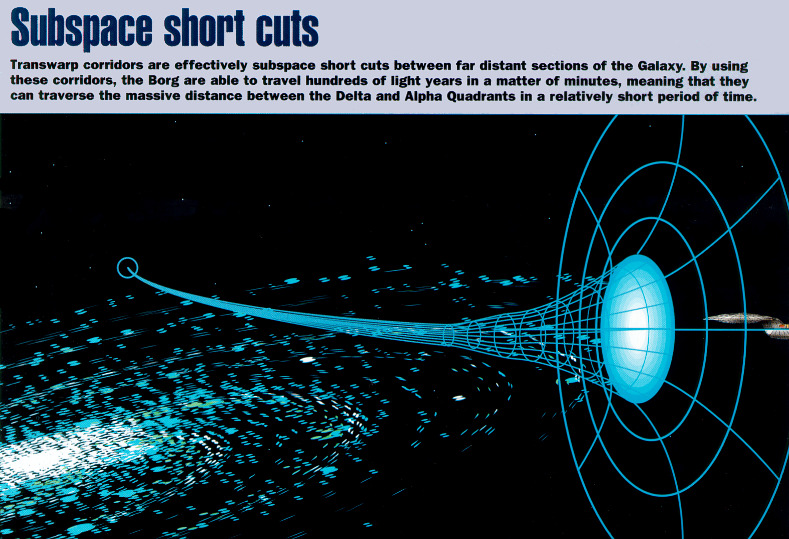|
Time Travel Research Center © 2005 Cetin BAL - GSM:+90 05366063183 - Turkey/Denizli
Wormholes In Space
Any links on this page will take you to more specific information about the
topic and out of this website.
Astro Weekly:
July 7, 2002
Fall into a black hole and you face instant annihilation, according to
traditional wisdom. But some astronomers think that black holes could be
gateways instead of dead ends - that they may open the way to wormholes,
tunnels through space-time that could lead in an instant to past or future
epochs, to far-flung regions of the cosmos, or even to other universes.
Wormholes do not appear to violate any of the currently understood laws of
physics. Whether they can exist in nature, though, is still not known.
Quick Facts:
Linking Laws: Some physicists think that the universe may be
riddled with ultra-microscopic wormholes that allow information to pass
between vastly separated regions of the cosmos. This would ensure that the
laws of physics were the same everywhere.
First Thoughts: Austrian physicist Ludwig Flamm was the first to
suggest the possibility of wormholes - only a year after Albert Einstein
published his General Theory of Relativity. But Flamm didn't actually use
the term "wormholes," and their significance was not recognized at the
time.

Tunnel Vision
Wormholes, as their name suggests, are like burrows. But rather than
tunneling trough soil, they wind through a dimension of space and time that
we cannot see - so-called hyperspace. An ant can walk more quickly between
two surface points on a hill by tunneling through the mound than by going
over its surface. In exactly the same way, an object could pass from one
part of the cosmos to another much faster if it could burrow through the
fabric of space and time instead of being forced to travel through it. A
wormhole is a theoretical tunnel that might allow such a feat.
Physicists Ludwig Flamm in Austria and Karl Schwarzchild in Germany
independently conceived the the idea of a tunnel through hyperspace in 1916.
Later, in the 1930's, Albert Einstein and his colleague Nathan Rosen, both
working at Princeton University, developed the idea more fully and derived
the Einstein-Rosen bridge. This was a neck connecting two spinning black
holes, objects so dense that not even light can escape their gravity.
At the time, the Einstein-Rosen bridge was seen as nothing more than the
bizarre theoretical outcome of one solution to the equations of Einstein's
General Theory of General Relativity. Most theorists thought that if you
fell into a black hole, you would be squashed to a point of infinite density
and zero size - called a singularity - at the hole's origin. So even if
there were such a bridge, nothing could cross it and live to tell the tale.
True Story
Thorny Problems:
The idea of wormholes has been around for decades, but it was the work of
U.S. physicist
Kip Thorne that helped to popularize it.
Thorne, who is Feynman Professor of
Theoretical Physics at the California Institute of Technology (CalTech),
Pasadena, once suggested that passage through a wormhole might be possible
if the hole could be held open long enough. Nowadays, though, he is more
skeptical about the idea.
Propping The Door Open
In the mid-1980s, U.S. physicist
Kip Thorne
proposed that falling into a black hole might not end in tragedy after all.
Mathematically, he showed that if the mouth of the wormhole in a rotating
black hole could be forced to stay open, a trip through it might be possible.
A person could enter the wormhole at one end and emerge in an entirely
different part of the universe altogether. The trick was to get the wormhole
to keep its mouth open.
To keep a wormhole open requires something almost as bizarre as a wormhole
itself: exotic matter. Unlike ordinary matter, exotic matter always exerts a
negative pressure. It you were to pump exotic matter into a tire, the more
you put in, the flatter the tire would get. This, Thorne showed, was the key
to surviving a fall through the throat of a wormhole. If enough exotic
matter could somehow be fed into the wormhole's mouth, the powerful negative
pressure that it generated would counteract gravity and prevent the gate
from closing.
Strane as these concepts are, they do not violate the current laws of
physics. Scientists already have indirect evidence for the existence of
small amounts of exotic matter. But we are still a very long way from the
technology needed to turn these theories into a workable method of
intergalactic space travel.

Wormhole Timeline:
- 1915: Albert Einstein publishes his General Theory of
Relativity, incorporating field equations that express how matter has an
effect on both space and time.
- 1916: German physicist Karl Schwarzschild solves field
equations for a non-rotating black hole. He and Austrian physicist Ludwig
Flamm simultaneously but independently suggest a tunnel through space-time
between black holes.
- 1933: Einstein and fellow Princeton scientist Nathan Rosen
solve Einstein's equations and derive the Einstein-Rosen Bridge - the
first mathematically proven wormhole.
- 1948: Austrian mathematician Kurt Godel shows that tunnels in
time may be possible.
- 1950s: Princeton scientist John Wheeler invents the term "wormhole."
He coins the term black hole in the late 1960s.
- 1985: Caltech astrophysicist
Kip Thorne and colleagues suggest in the
scientific paper "Wormholes, Time Machines and the Weak Energy Condition"
that traversable wormholes could exist.
Alıntı:
http://www.midtel.net/~cjworeth
Resource: The Secrets of the Universe.
Hiçbir yazı/ resim kaynak
gösterilmeden kullanılamaz!! Telif hakları uyarınca bu bir suçtur..! Tüm
hakları Çetin BAL' a aittir.
The Time
Machine Project © 2005 Cetin BAL - GSM:05366063183 -Turkiye/Denizli
::|::Home::|::Anasayfa::|::İndex::|::Warp
drive::|::Wormhole::|::
Ana Sayfa · İndex· Ziyaretçi
Defteri
 E-Mail
Kuantum Teleportation
E-Mail
Kuantum Teleportation
Time Travel Technology
UFO Technology
Roket bilimi
CetinBAL
|

